
- Home
- Travel Packages
- Top Destination
-
Travel Attraction
By Category
Top Attraction

- Travel Agents
- Car Rentals
- Hotels
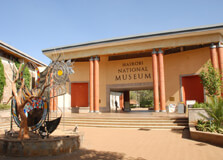
National Museums of Kenya is a State run Cooperation meant to maintain several museums, monuments and important sites of Kenya, Africa. Some of the various popular museums that come under the Cooperation of National Museums of Kenya are Natural History Museum, National Museum, Coryndon Museum and Gallery of Kenyan Ethnic Communities. All these museums and the wide range of events and modern facilities have made the organization of National Museums of Kenya a major tourist spot of Kenya. About The Nairobi National Museum The Nairobi National Museum stands as a cultural beacon in the heart of Kenya's capital, offering a captivating journey through the country's rich history, diverse cultures, and natural wonders. Situated within lush botanical gardens, the museum serves as a repository of Kenya's heritage, showcasing an extensive collection of artifacts, exhibits, and interactive displays that celebrate the nation's cultural tapestry. History of the National Museum Established in 1920, the Nairobi National Museum has evolved into one of East Africa's premier cultural institutions. Initially founded as a humble exhibition space for geological and natural history specimens, the museum has since expanded its scope to encompass anthropology, archaeology, paleontology, and contemporary art. Over the decades, it has played a pivotal role in preserving Kenya's cultural heritage, fostering scholarly research, and promoting public engagement with the arts and sciences. The museum's diverse collection spans millions of years of human history and natural evolution, offering visitors a multifaceted exploration of Kenya's past, present, and future. From ancient fossils and archaeological treasures to contemporary artworks and ethnographic displays, the museum's exhibits provide a comprehensive overview of Kenya's cultural, ecological, and scientific heritage. Time to Visit The Nairobi National Museum welcomes visitors year-round, providing an enriching experience for tourists, locals, and scholars alike. Whether you're planning a leisurely stroll through the museum's galleries, attending a special exhibition opening, or participating in educational programs and workshops, there's always something exciting happening at the museum. While weekdays tend to be less crowded, weekends often feature special events, performances, and family-friendly activities. Entry Fee Admission to the Nairobi National Museum is affordably priced, making it accessible to visitors of all ages and backgrounds. The nominal entry fee helps support the museum's conservation efforts, educational initiatives, and community outreach programs. Discounts may be available for children, students, seniors, and members of certain organizations, ensuring that everyone has the opportunity to experience the museum's treasures firsthand. Time Required for Travel Exploring the Nairobi National Museum is a rewarding endeavor that can be tailored to fit your schedule and interests. While some visitors may choose to spend a couple of hours perusing the museum's exhibits, others may opt for a more leisurely exploration spanning half a day or longer. With its diverse array of galleries, gardens, and outdoor installations, the museum offers something for everyone to enjoy, whether you're a history buff, an art enthusiast, or simply curious about the world around you. Traveling Tips When planning your visit to the Nairobi National Museum, it's helpful to arrive prepared for an enriching and enjoyable experience. Consider wearing comfortable clothing and footwear suitable for walking and exploring the museum's indoor and outdoor spaces. Bringing along a camera or smartphone to capture memorable moments is also recommended. Additionally, visitors may wish to check the museum's website or contact the staff in advance to inquire about any special exhibitions, guided tours, or events taking place during their visit. Planning your trip accordingly can enhance your understanding and appreciation of Kenya's cultural heritage and natural diversity. Moreover, don't forget to set aside some time to explore the museum's surrounding grounds, including its tranquil botanical gardens, outdoor sculptures, and scenic viewpoints. Whether you're a history aficionado, an art lover, or simply looking for a peaceful retreat from the bustle of city life, the Nairobi National Museum offers a captivating blend of education, entertainment, and inspiration for all who visit.
Explore More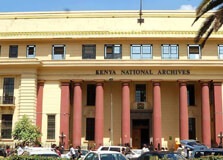
The National Archives Museum of Kenya, Africa has a lot of cultural importance to the whole of Africa. The museum has a varied collection of paintings and photographs specific to the tribes of Africa. Tribal belongings like weaponry, masks and other used instruments are the major exhibits of The National Archives Museum of Kenya, and give a clear insight to the African culture. People interested in history are sure to be enlightened about the freedom struggle of Africans through a visit to the museum. It is a must visit place for all types of tourists. About The National Archives Museum The National Archives Museum in Nairobi, Kenya, is a cornerstone of the nation's cultural heritage, housing a vast collection of historical documents, photographs, and artifacts that trace Kenya's journey through time. Situated in the heart of the city, the museum serves as a vital repository of the country's collective memory, offering visitors a window into its past, present, and future. From ancient manuscripts to modern government records, the museum's exhibits showcase the rich tapestry of Kenyan history, culture, and identity, making it a must-visit destination for scholars, researchers, and curious minds alike. History of the National Archives Museum Established in 1965, the National Archives Museum has played a pivotal role in preserving Kenya's archival heritage and promoting historical awareness among its citizens. Originally founded to safeguard important government documents and records, the museum has since expanded its scope to include a diverse array of materials spanning various periods and subjects. Over the years, it has become a focal point for academic research, educational programming, and public engagement, earning recognition as one of East Africa's premier archival institutions. The museum's collections encompass a wide range of materials, including manuscripts, photographs, maps, audiovisual recordings, and ephemera. These artifacts offer valuable insights into Kenya's political, social, economic, and cultural history, shedding light on significant events, personalities, and movements that have shaped the nation's identity and trajectory. Time to Visit The National Archives Museum welcomes visitors throughout the year, providing an enriching and immersive experience for individuals and groups of all ages. Whether you're a student conducting research, a history enthusiast exploring Kenya's past, or a traveler seeking to learn more about the country's heritage, the museum offers something for everyone to enjoy. While weekdays tend to be quieter, weekends may see increased foot traffic, especially during special exhibitions or events. Entry Fee Admission to the National Archives Museum is typically affordable, ensuring accessibility for all visitors. The nominal entry fee, if applicable, helps support the museum's conservation efforts, educational initiatives, and public programs. Discounts may be available for students, seniors, and members of certain organizations, making it easy for everyone to access and appreciate Kenya's archival treasures. Time Required for Travel Exploring the National Archives Museum can be a rewarding and enlightening experience that varies in duration depending on individual interests and preferences. While some visitors may spend a few hours browsing the exhibits and perusing the archives, others may choose to delve deeper into specific topics or collections, necessitating a longer stay. With its comprehensive holdings and rotating exhibitions, the museum offers ample opportunities for discovery and reflection, making it an ideal destination for both casual visitors and serious researchers. Traveling Tips Before visiting the National Archives Museum, it's advisable to check the museum's operating hours and any special exhibitions or events taking place during your visit. Additionally, consider bringing along a notebook or camera to document any interesting findings or insights gleaned from the exhibits. Respecting the museum's guidelines regarding photography, food and drink, and handling of archival materials helps ensure the preservation of its priceless artifacts for future generations to appreciate. Finally, take some time to explore the surrounding area, as Nairobi boasts a wealth of cultural attractions, historic landmarks, and vibrant markets waiting to be discovered. Whether you're a seasoned researcher or a curious traveler, the National Archives Museum offers a fascinating glimpse into Kenya's past and present, inviting visitors to uncover the stories that have shaped the nation's identity and collective memory.
Explore More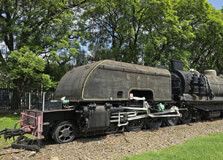
Nairobi Railway Museum in the capital city Nairobi of Kenya, Africa is an interesting place of visit, to get closer to the history of invention and technology of different rails. The museum exhibits the locomotives of the long non-operational East African Railways. Nairobi Railway Museum has some operational railway connections, which allows the museum to maintain those locomotives better. In addition, with these operational lines the museum organizes excursion programs for tourists sometimes. The collection of Nairobi Railway Museum has increased reasonably after 1940s. It is one of the most popular tourists’ attractions of Kenya. About The Nairobi Railway Museum The Nairobi Railway Museum stands as a testament to Kenya's rich railway heritage, offering visitors a captivating journey through time. Nestled within the historic Nairobi Railway Station, this museum serves as a treasure trove of locomotives, coaches, and artifacts that chronicle the evolution of Kenya's railway system. As one of the premier railway museums in Africa, it beckons enthusiasts, history buffs, and curious minds alike to explore its immersive exhibits. History of Nairobi Railway Museum The roots of the Nairobi Railway Museum trace back to the late 19th century when Kenya was under British colonial rule. The railway network, initially constructed to facilitate the transport of goods such as ivory and goods, gradually evolved into a vital artery of transportation and communication across the country. Nairobi, as the epicenter of Kenya's railway system, became home to a bustling railway station, which eventually evolved into the present-day museum. The museum's collection comprises a diverse array of artifacts, including steam locomotives, diesel engines, and vintage coaches, each bearing witness to Kenya's railway legacy. These relics vividly depict the ingenuity, engineering prowess, and human endeavor that shaped Kenya's railway history. Time to Visit The Nairobi Railway Museum welcomes visitors throughout the year, offering an enriching experience regardless of the season. However, it's advisable to check for any seasonal variations in operating hours or special events before planning your visit. Whether you're a solo traveler, a family seeking educational outings, or a group of friends with a penchant for exploration, the museum promises an engaging excursion for all. Entry Fee Admission to the Nairobi Railway Museum is typically affordably priced, making it accessible to a wide range of visitors. The nominal entry fee ensures that patrons can immerse themselves in Kenya's railway heritage without breaking the bank. Additionally, special discounts may be available for children, students, and seniors, further enhancing the affordability of the museum experience. Time Required for Travel Exploring the Nairobi Railway Museum is a leisurely endeavor that can be tailored to suit individual preferences and schedules. While some visitors may choose to breeze through the exhibits in a couple of hours, others may opt for a more comprehensive exploration spanning half a day or longer. The museum's captivating displays, guided tours, and interactive activities offer ample opportunities for deep dives into Kenya's railway history, ensuring that every moment spent here is both informative and enjoyable. Traveling Tips For those planning a visit to the Nairobi Railway Museum, it's advisable to arrive prepared to make the most of your experience. Consider wearing comfortable attire and footwear suitable for walking and exploring the museum's indoor and outdoor exhibits. Bringing along a camera or smartphone to capture memorable moments is also recommended. Additionally, visitors may wish to check the museum's website or contact the staff in advance to inquire about any guided tours, special exhibitions, or events taking place during their visit. Planning your trip accordingly can enhance your understanding and appreciation of Kenya's railway heritage. Moreover, don't forget to allocate some time to explore the surrounding area, including the Nairobi Railway Station and its environs, which boast their own historical charm and architectural significance. Whether you're a railway enthusiast, a history aficionado, or simply a curious traveler, the Nairobi Railway Museum offers a captivating glimpse into Kenya's past and present, making it a must-visit destination for all.
Explore More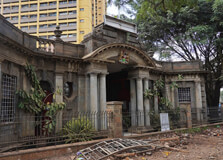
Nairobi Gallery About The Nairobi Gallery The Nairobi Gallery, located in Nairobi, Kenya, is a cultural gem housed within the historic former Provincial Commissioner's offices. This elegant building, dating back to the early 20th century, provides an exquisite setting for showcasing Kenya's rich artistic heritage. The gallery boasts a diverse collection of paintings, sculptures, photographs, and artifacts that celebrate the country's vibrant artistic traditions and cultural diversity. From traditional African artworks to contemporary pieces by local and international artists, the Nairobi Gallery offers visitors a captivating journey through Kenya's artistic evolution and creative expression. History of Nairobi Gallery Originally constructed in 1913, the building that now houses the Nairobi Gallery served as the offices of the Provincial Commissioner during Kenya's colonial era. After undergoing extensive renovations, it was transformed into a gallery space in 2005, with the aim of promoting and preserving Kenya's cultural heritage. Since then, the Nairobi Gallery has become a hub for artistic expression and cultural exchange, hosting exhibitions, workshops, and educational programs that engage both local communities and international visitors. Time to Visit The Nairobi Gallery welcomes visitors from Tuesday to Sunday, providing ample opportunities to explore its collections and exhibitions. The gallery is typically open from 10:00 AM to 6:00 PM, although visitors are advised to check the official website or contact the gallery directly for any updates on opening hours or special events. Weekdays tend to be less crowded, offering a quieter and more intimate experience for those seeking to immerse themselves in the artworks on display. Entry Fee Admission to the Nairobi Gallery is affordably priced, making it accessible to visitors of all ages and backgrounds. The nominal entry fee helps support the gallery's conservation efforts, educational initiatives, and cultural programming. Special discounts may be available for students, seniors, and members of certain organizations, further enhancing the accessibility of the gallery experience. Additionally, donations are always appreciated and contribute to the ongoing maintenance and development of the gallery's collections and facilities. Time Required for Travel Traveling to the Nairobi Gallery is convenient, as it is located in the heart of Nairobi's central business district. The gallery is easily accessible by car, taxi, or public transportation, with various parking options available nearby. The travel time may vary depending on your starting point within Nairobi, but most visitors can expect to reach the gallery within 30 to 45 minutes. Once there, plan to spend at least an hour exploring the gallery's exhibitions and collections, although art enthusiasts may choose to extend their visit to fully appreciate the diverse range of artworks on display. Traveling Tips Before visiting the Nairobi Gallery, it's advisable to check the gallery's website or social media channels for any updates on opening hours, exhibitions, or events. Consider joining a guided tour or attending a special workshop or lecture to enhance your gallery experience and gain deeper insights into the artworks and artists featured. Wear comfortable clothing and footwear suitable for walking, as you'll likely be exploring the gallery's exhibition spaces and historic building. Lastly, don't forget to bring along a camera or smartphone to capture memorable moments and artworks during your visit to the Nairobi Gallery.
Explore More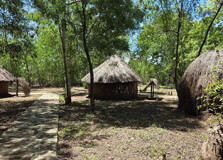
About The Bombolulu Workshop And Cultural Centre The Bombolulu Workshop and Cultural Centre, located in Mombasa, Kenya, is a renowned non-profit organization that empowers people with disabilities through the production and sale of handcrafted items. This center is a significant social enterprise that combines a rich cultural experience with economic development. Established in 1969, the center has grown to become one of the largest rehabilitation programs in Kenya, offering employment opportunities, skills training, and a sense of community for hundreds of individuals. Bombolulu is not just a workshop; it is a vibrant cultural hub. Visitors can explore various workshops where artisans create beautiful jewelry, textiles, wood carvings, and leather goods. These products are not only sold locally but are also exported worldwide, ensuring sustainable livelihoods for the artisans. The center also features a cultural village that showcases traditional Kenyan homesteads, offering a glimpse into the diverse cultures and traditions of Kenya’s ethnic communities. Additionally, the center includes a restaurant that serves traditional Kenyan cuisine, providing an authentic culinary experience. History of Bombolulu Workshop And Cultural Centre The history of Bombolulu Workshop and Cultural Centre dates back to 1969 when it was established by the Association for the Physically Disabled of Kenya (APDK). The primary goal was to provide vocational training and employment opportunities to people with disabilities, who often face significant barriers to employment in mainstream sectors. Over the decades, Bombolulu has expanded its scope and impact, evolving from a small workshop into a comprehensive rehabilitation and cultural center. In its early years, Bombolulu focused on providing basic vocational training in areas such as tailoring, carpentry, and leatherwork. As the organization grew, it began to incorporate more sophisticated crafts and skills, including jewelry making and textile design. The introduction of these new crafts not only diversified the product range but also attracted a broader market, both locally and internationally. The cultural village was added in the 1980s as a way to enhance the center’s appeal to tourists and educate visitors about Kenya’s rich cultural heritage. This addition has helped to increase visitor numbers and generate additional revenue to support the center’s programs. Today, Bombolulu stands as a testament to the power of inclusive development and the positive impact of empowering people with disabilities. Time to Visit Bombolulu Workshop and Cultural Centre is open year-round, making it a great destination to visit at any time. However, the best time to visit Mombasa, in general, is during the dry season, which runs from July to October and from January to February. During these months, the weather is typically sunny and pleasant, with lower humidity levels, making it more comfortable to explore the outdoor aspects of the center, such as the cultural village. Visiting during the dry season also means that you are less likely to encounter rain, which can sometimes hinder outdoor activities. Additionally, this period coincides with the peak tourist season, so you can expect the center to be lively with various activities and performances. However, if you prefer a quieter experience with fewer crowds, consider visiting during the shoulder seasons of June and November. Entry Fee The entry fee for Bombolulu Workshop and Cultural Centre is quite reasonable, ensuring that it is accessible to both local and international visitors. As of the latest updates, the entry fee for adults is approximately KES 500 (about USD 5), while children are charged KES 250 (about USD 2.50). Special rates may apply for groups and school visits, and it is advisable to check the official website or contact the center directly for the most current pricing and any available discounts. The entry fee includes access to all the workshops, the cultural village, and the various exhibits. Guided tours are also available at no extra cost, offering visitors an in-depth understanding of the center’s work and the cultural significance of the items on display. The revenue generated from the entry fees is used to support the center’s programs and initiatives, ensuring that Bombolulu can continue to provide valuable services to people with disabilities. Time Required for Travel When planning a visit to Bombolulu Workshop and Cultural Centre, it is essential to allocate sufficient time to fully enjoy the experience. Most visitors spend approximately 2 to 3 hours at the center. This time frame allows for a comprehensive tour of the workshops, a leisurely stroll through the cultural village, and the opportunity to shop for unique handcrafted items. If you plan to have a meal at the on-site restaurant, you might want to add an extra hour to your visit. Additionally, if you are traveling from central Mombasa, you should factor in travel time, which can vary depending on traffic conditions. The center is located about 10 kilometers from the city center, and the journey typically takes around 30 minutes by car. It is advisable to plan your visit during off-peak hours to avoid heavy traffic and ensure a smoother journey. Traveling Tips Plan Ahead: Check the center’s official website or contact them directly for the latest information on opening hours, entry fees, and any special events or exhibitions. Wear Comfortable Clothing: As the center includes both indoor and outdoor areas, it is recommended to wear comfortable clothing and footwear suitable for walking. Carry Sunscreen and Water: If you are visiting during the hotter months, make sure to carry sunscreen and a bottle of water to stay hydrated and protected from the sun. Support the Artisans: Consider purchasing some of the handcrafted items from the workshops. Not only will you be getting a unique souvenir, but you will also be supporting the artisans and the center’s programs. Hire a Guide: To get the most out of your visit, consider hiring a guide who can provide detailed insights into the center’s operations and the cultural significance of the exhibits. Visit During Special Events: Keep an eye out for any special events or cultural performances that might be scheduled during your visit. These events can provide additional entertainment and a deeper understanding of Kenyan culture. Respect the Artisans and Staff: Remember that Bombolulu is a working center, and the artisans are professionals at work. Be respectful and considerate during your visit.
Explore More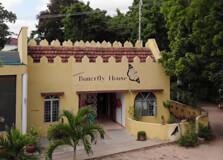
About The Mombasa Butterfly House The Mombasa Butterfly House offers a captivating experience in the heart of Mombasa, Kenya, where visitors can immerse themselves in the beauty and diversity of butterflies. Nestled amidst lush tropical gardens, this sanctuary provides a unique opportunity to observe these delicate creatures up close in their natural habitat. The Butterfly House is not just a place to see butterflies; it's a conservation effort aimed at preserving these species and educating the public about their importance in the ecosystem. Whether you're a nature enthusiast, a photographer seeking stunning shots, or a family looking for an educational outing, the Mombasa Butterfly House promises a memorable experience for all. History of Mombasa Butterfly House The Mombasa Butterfly House was established with the vision of creating a sanctuary that celebrates the biodiversity of butterflies in Kenya. It was founded by passionate conservationists who aimed to provide a space where both locals and tourists could learn about and appreciate these enchanting insects. Since its inception, the Butterfly House has grown not only as a tourist attraction but also as a center for research and education. Through partnerships with local conservation organizations and educational institutions, the Butterfly House continues to play a vital role in raising awareness about environmental conservation and the preservation of butterfly species. Time to Visit The Mombasa Butterfly House is open throughout the year, making it convenient for visitors to plan their trip according to their schedule. However, the best time to visit is during the morning hours when butterflies are most active and the weather is generally cooler. This allows for optimal viewing and photography opportunities amidst the tranquil setting of the gardens. Entry Fee As of the latest update, the entry fee for the Mombasa Butterfly House is reasonable, catering to both individual visitors and families. The fee structure often includes discounts for children and seniors, making it an affordable outing for all age groups. Visitors may also have the option to purchase guided tours or participate in educational programs offered by the Butterfly House. Time Required for Travel The travel time to the Mombasa Butterfly House can vary depending on your starting point within Mombasa. From the city center or popular tourist areas, it typically takes around 30 to 45 minutes by car. Visitors are advised to factor in additional time for traffic conditions, especially during peak hours or on weekends when tourist traffic might be higher. Traveling Tips Best Time to Visit: Aim for the morning hours for the best butterfly viewing experience. Photography: Bring your camera or smartphone to capture stunning shots of butterflies and the picturesque gardens. Clothing: Wear comfortable clothing and shoes suitable for walking in a garden setting. Guided Tours: Consider taking a guided tour to learn more about the butterflies and the conservation efforts of the Butterfly House. Souvenirs: Support the conservation efforts by purchasing souvenirs from the gift shop, which often sells butterfly-themed items and educational materials. In conclusion, the Mombasa Butterfly House offers a delightful blend of education, conservation, and natural beauty, making it a must-visit destination for anyone interested in butterflies and nature. Whether you're a local resident or a tourist exploring Kenya, this sanctuary provides a serene escape into the world of butterflies, leaving visitors with a newfound appreciation for these fascinating insects and their role in our ecosystem.
Explore More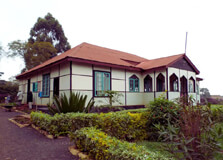
About The Rabai Museum The Rabai Museum, situated near Mombasa in Kenya, stands as a testament to the rich history and cultural heritage of the region. Established to preserve and showcase the heritage of the Rabai community, the museum provides a fascinating insight into the traditions, lifestyle, and historical significance of this coastal community. History of Rabai Museum The Rabai Museum is located in Rabai, a historic settlement that holds immense cultural importance in Kenya. Rabai was one of the first places in Kenya where Christian missionaries settled, dating back to the 19th century. The museum itself was established to commemorate this historical milestone and to preserve the artifacts, documents, and stories that highlight the interaction between European missionaries and the local Rabai community. The exhibits chronicle the journey of Christianity in Kenya, including the pioneering efforts of figures like Johann Ludwig Krapf, who played a pivotal role in introducing Christianity to East Africa. Time to Visit The Rabai Museum is open to visitors throughout the year. The best time to visit is during the cooler months of June to September and January to February, when the weather is more comfortable for exploring outdoor attractions. Entry Fee The entry fee to the Rabai Museum is typically affordable, catering to both local and international visitors. Prices are subject to change, so it's advisable to check current rates before planning your visit. Time Required for Travel The travel time to the Rabai Museum from Mombasa city center is approximately 45 minutes to 1 hour by road, depending on traffic conditions. It's recommended to plan for additional time if traveling during peak traffic hours or on weekends. Traveling Tips When visiting the Rabai Museum, consider the following tips to make the most of your experience: Transportation: Arrange for reliable transportation to and from the museum, as public transport options may be limited. Guided Tours: Opt for a guided tour if available, as it can provide deeper insights into the exhibits and the history of Rabai. Weather Considerations: Kenya's coastal region can be hot and humid, so dress comfortably and carry adequate water and sun protection. Respect Cultural Norms: While visiting the museum and the surrounding area, respect local customs and traditions, including dress codes if applicable. Visiting the Rabai Museum offers a unique opportunity to delve into the cultural mosaic of Kenya's coastal communities and explore the early roots of Christianity in East Africa. Whether you are a history enthusiast, a cultural explorer, or simply seeking a deeper understanding of Kenya's heritage, the Rabai Museum promises a rewarding experience that reflects the intersection of tradition, faith, and history.
Explore More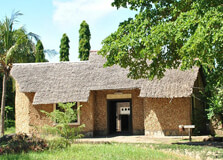
About The Bombolulu Workshop and Cultural Centre
About The Bombolulu Workshop and Cultural Centre The Bombolulu Workshop and Cultural Centre, located in Mombasa, Kenya, is a renowned organization dedicated to empowering people with disabilities through vocational training and employment. Established as a social enterprise, it provides a sustainable livelihood for its artisans and plays a pivotal role in the local community. The centre offers a range of handcrafted products including jewelry, textiles, wood carvings, and leather goods, all produced by skilled artisans. These items are not only sold locally but also exported, enhancing the visibility of Kenyan craftsmanship on the global stage. Beyond its commercial activities, Bombolulu Workshop and Cultural Centre is also a vibrant cultural hub. It offers visitors a unique opportunity to explore Kenyan culture through traditional dances, music, and craft demonstrations. The centre features a cultural village where replicas of traditional Kenyan homes are on display, providing insight into the diverse lifestyles of different Kenyan tribes. This combination of social impact, cultural preservation, and economic contribution makes Bombolulu a significant attraction in Mombasa, drawing visitors who are keen to support ethical tourism and learn more about Kenya's rich cultural heritage. History of Bombolulu Workshop and Cultural Centre Bombolulu Workshop and Cultural Centre was founded in 1969 by the Association for the Physically Disabled of Kenya (APDK). Initially, it started as a small initiative aimed at providing vocational training to individuals with physical disabilities, who often faced severe discrimination and lack of employment opportunities. The workshop began with a few artisans working on simple crafts and gradually expanded as the demand for their unique products grew. In the early years, the centre focused primarily on training and producing small handicrafts. However, with increased support from both local and international partners, Bombolulu was able to broaden its scope. By the 1980s, it had grown into a comprehensive facility offering not just vocational training but also employment opportunities, healthcare, and housing for its artisans. This holistic approach significantly improved the quality of life for people with disabilities, enabling them to gain financial independence and social acceptance. Throughout the decades, Bombolulu has continually adapted and evolved. The introduction of a cultural centre in the 1990s marked a significant expansion, allowing Bombolulu to showcase Kenya's diverse cultural heritage to a broader audience. Today, Bombolulu is recognized as one of the largest rehabilitation centres in Kenya, supporting hundreds of artisans and their families while also contributing to the preservation of Kenyan culture through its educational and cultural programs. Time to Visit The Bombolulu Workshop and Cultural Centre is open year-round, making it accessible to visitors at any time. However, the best time to visit Mombasa and, consequently, Bombolulu is during the dry seasons, from January to March and from July to October. These months offer pleasant weather conditions, making it ideal for exploring the outdoor cultural village and enjoying the various activities offered at the centre. During the rainy seasons, which occur from April to June and October to December, the weather can be unpredictable with heavy downpours. While the centre remains open, visitors might find it less comfortable to move around, especially in the outdoor areas. Therefore, planning your visit during the dry months can enhance your experience, allowing you to fully enjoy all the offerings without weather-related disruptions. Entry Fee The entry fee to the Bombolulu Workshop and Cultural Centre is quite reasonable, making it accessible to a wide range of visitors. As of the latest information, the entry fee for adults is approximately 500 Kenyan Shillings (around 5 USD), while children are charged 250 Kenyan Shillings (around 2.50 USD). This fee includes a guided tour of the workshops, the cultural village, and live cultural performances, providing excellent value for money. Additionally, the funds generated from entry fees directly support the artisans and the various programs run by Bombolulu, ensuring that your visit contributes to a worthy cause. Special group rates and educational tours can also be arranged, making it an excellent destination for school trips and organized tours. Time Required for Travel The time required to fully explore Bombolulu Workshop and Cultural Centre can vary depending on your interests. On average, visitors should allocate about 2 to 3 hours for a comprehensive tour. This timeframe allows you to visit the various workshops, interact with the artisans, explore the cultural village, and enjoy the cultural performances. If you have a deeper interest in handicrafts or wish to spend more time learning about the different aspects of the centre, you might want to extend your visit. Additionally, if you plan to shop for handcrafted items, allocate extra time to browse through the wide range of products available. Traveling Tips Plan Your Visit: Check the weather forecast and plan your visit during the dry season for a more enjoyable experience. Mornings are generally cooler and less crowded. Guided Tours: Opt for guided tours to gain deeper insights into the work being done at Bombolulu and to better appreciate the craftsmanship involved in the products. Wear Comfortable Clothing: The centre involves a lot of walking, especially in the cultural village, so wear comfortable shoes and light clothing. Support the Artisans: Consider purchasing some of the handcrafted items as souvenirs. The sales directly support the artisans and help sustain the centre's operations. Photography: Don’t forget to bring your camera. The cultural village and workshops offer excellent photo opportunities. Transportation: Bombolulu is located about 5 kilometers from the Mombasa city center. You can take a taxi or use ride-sharing services for a convenient trip. Respect Local Customs: When visiting the cultural village, be respectful of the traditions and customs displayed. It’s an educational experience that highlights the rich cultural diversity of Kenya. Health Precautions: Mombasa can be quite hot and humid, so stay hydrated and use sunscreen. Also, ensure you have any necessary vaccinations or medications as recommended for travel in Kenya.
Explore More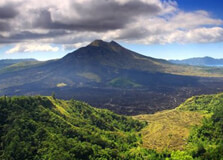
Please provide detailed content about the Menengai Crater Nakuru Kenya - required 800 words minimum and in normal English. please include the below topic in your provided content and need the proper heading, and paragraph in your display output - About The Menengai Crater in 200 words, History of Menengai Crater , Time to Visit , Entry Fee, Time Required for travel, Traveling tips About The Menengai Crater Menengai Crater, situated near Nakuru in Kenya, is a breathtaking natural wonder that captivates visitors with its immense size and stunning surroundings. This colossal shield volcano, boasting a diameter of approximately 12 kilometers (7.5 miles) and depths reaching 500 meters (1,640 feet), is among the largest volcanic calderas globally. Its formation dates back around 200,000 years, stemming from a volcanic eruption that sculpted the landscape into the striking vista we see today. History of Menengai Crater The history of Menengai Crater is steeped in geological evolution and cultural significance. Its creation was a result of volcanic activity during ancient times, shaping the region's terrain and leaving behind a majestic caldera that continues to intrigue scientists and tourists alike. Over the centuries, local communities have formed connections with the crater, incorporating it into their folklore and traditions. Today, Menengai Crater stands as a testament to the Earth's geological processes and serves as a symbol of Kenya's rich natural heritage. Time to Visit The best time to visit Menengai Crater is during the dry season, which typically spans from June to September. During this period, the weather is pleasant, with clear skies and mild temperatures, making it ideal for outdoor exploration and sightseeing. However, visitors should be prepared for cooler evenings, especially at higher elevations near the crater rim. Additionally, wildlife viewing opportunities are abundant during the dry season, as animals gather around water sources within the crater. Entry Fee As of the latest information, the entry fee for Menengai Crater varies depending on whether visitors are Kenyan citizens or foreigners. Kenyan citizens typically pay a lower fee, while foreigners are charged a slightly higher rate. It's advisable to check with local authorities or tour operators for the most up-to-date information regarding entry fees and any additional charges for guided tours or amenities. Time Required for Travel The amount of time required for a visit to Menengai Crater can vary based on individual preferences and interests. A typical excursion to the crater may span several hours to a full day, allowing ample time for hiking, wildlife spotting, and soaking in the breathtaking scenery. For those seeking a more in-depth experience, overnight camping options are available within the crater area, providing an opportunity to witness stunning sunrises and sunsets against the backdrop of this natural wonder. Traveling Tips Pack Accordingly: Be sure to bring adequate clothing and gear, including sturdy hiking shoes, sunscreen, and plenty of water. Respect Wildlife: While exploring the crater, maintain a safe distance from any wildlife encountered and refrain from feeding or approaching animals. Stay Informed: Before embarking on your journey, check weather forecasts and trail conditions to ensure a safe and enjoyable experience. Plan Ahead: Consider booking guided tours or hiring local guides to enhance your visit and gain insights into the crater's geology, history, and biodiversity. By following these tips and taking the time to appreciate the beauty and significance of Menengai Crater, visitors can create unforgettable memories while exploring this remarkable natural marvel in the heart of Kenya.
Explore More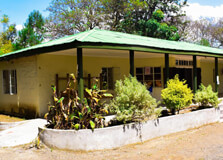
About The Hyrax Hill Museum The Hyrax Hill Museum, located near Nakuru in Kenya's Rift Valley, is a fascinating archaeological site and museum that offers visitors a glimpse into the prehistoric past of East Africa. Situated atop a hill overlooking Lake Nakuru, the museum is named after the hyrax, a small mammal whose fossils were discovered in the area alongside stone tools and other artifacts dating back over 3,000 years. The museum's exhibits showcase the rich cultural heritage and ancient civilizations that once thrived in the region, including the early hunter-gatherer communities, pastoralists, and iron-age settlers who left behind a legacy of stone-built enclosures, pottery, and artifacts. Visitors to the Hyrax Hill Museum can explore the archaeological site, view the excavated remains, and learn about the archaeological research and discoveries that have shed light on the prehistoric peoples of Kenya's Rift Valley. Hyrax Hill Museum The Hyrax Hill Museum is open to visitors throughout the year, with operating hours from 9:00 AM to 6:00 PM daily. The museum is best visited during the morning or late afternoon hours when the weather is mild, and the lighting is optimal for viewing the exhibits and exploring the outdoor archaeological site. Weekdays tend to be less crowded than weekends, making them ideal for a quieter and more immersive museum experience. Entry Fee There is a nominal entry fee to access the Hyrax Hill Museum, which helps support the maintenance and conservation of the archaeological site and museum exhibits. The fee may vary depending on age, nationality, and any additional amenities or services offered, such as guided tours or educational programs. Visitors are encouraged to check the official website or contact the museum directly for updated information on entry fees and any discounts or promotions available. Time Required for Travel Traveling to the Hyrax Hill Museum from Nakuru's city center is relatively easy, as it is located just a short distance away, approximately 4 kilometers from the town center. The museum is easily accessible by car, taxi, or public transportation, with designated parking available for those driving. The travel time may vary depending on traffic conditions and the route taken but typically takes around 15 to 20 minutes. Once at the museum, visitors should plan to spend at least an hour or two exploring the exhibits and archaeological site, although those with a keen interest in archaeology and history may choose to spend longer. Traveling Tips Before visiting the Hyrax Hill Museum, it's advisable to check the weather forecast and plan your trip accordingly, especially if you plan to explore the outdoor archaeological site. Wear comfortable walking shoes and dress in layers to accommodate changes in temperature throughout the day. Bring along a hat, sunscreen, and plenty of drinking water to stay hydrated, especially during hot and sunny weather. Consider bringing a camera or smartphone to capture photos of the museum exhibits and scenic views from the hilltop overlooking Lake Nakuru. Lastly, respect the archaeological site and museum artifacts by following any rules or guidelines provided by the museum staff and refraining from touching or removing any objects.
Explore More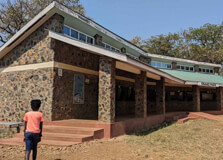
The Kisumu Museum is a significant cultural and historical landmark located in Kisumu City, on the shores of Lake Victoria, Kenya. Established to preserve and showcase the rich heritage of the region, the museum provides a deep dive into the history, culture, and biodiversity of Kisumu and the wider Nyanza region. With its fascinating exhibits and educational displays, Kisumu Museum has become one of the key attractions for both local and international visitors, offering a unique perspective on Kenya's diverse cultural landscape. Whether you're a history buff, a nature enthusiast, or a curious traveler, the museum offers something of interest for everyone. History and Overview The Kisumu Museum was founded in 1980 and is one of the oldest and most prominent museums in western Kenya. It was created with the purpose of preserving and presenting the cultural heritage of the Luo community, who are the dominant ethnic group in the Kisumu region. Over time, the museum expanded its focus to include the history and cultural practices of other ethnic groups in the Nyanza region, as well as showcasing the region's natural history and biodiversity. The museum is located on a beautiful 3-acre plot of land, with a picturesque backdrop of the surrounding landscapes. Its well-curated exhibitions tell the story of Kisumu's history, including its role as a key port for trade on Lake Victoria, its colonial past, and the development of Kisumu as a major urban center in Kenya. The museum also explores the cultural traditions of the Luo people, from their music and dance to their traditional clothing and rituals. Why It’s Famous The Kisumu Museum is famous for its comprehensive and diverse collection of exhibits that cover a wide range of topics. It is perhaps most well-known for its exhibitions on the Luo people, highlighting their history, art, and cultural practices. The museum also draws attention for its display of local wildlife, including preserved specimens of the region's animal species. The museum’s location on the shores of Lake Victoria further enhances its appeal, offering visitors an opportunity to learn about the environmental significance of the lake and its role in supporting local biodiversity. Additionally, the museum is famous for its outdoor exhibits, which include a recreated Luo traditional village, showcasing the architecture, tools, and lifestyle of the Luo people. This interactive exhibit allows visitors to step back in time and experience life as it was centuries ago in the Nyanza region. The Kisumu Museum is also known for being a center of research and education, providing a platform for scholars, tourists, and locals to engage with the cultural and environmental history of the area. Entry and Visit Details Opening Hours: The Kisumu Museum is open daily from 9:00 AM to 6:00 PM, with the exception of public holidays. Entry Fees: Adults: KES 200 (Kenyan Shillings) Children: KES 100 (Kenyan Shillings) Residents of Kisumu may enjoy a discount on entry fees. Best Time to Visit: The museum can be visited year-round, but the best time to visit is during the dry season (June to October) when the weather is cooler and more comfortable for exploring the outdoor exhibits. If you're interested in cultural events and exhibitions, it's best to check the museum's schedule in advance, as they often host cultural celebrations, workshops, and performances. Facilities: The museum offers guided tours, which are highly recommended for those who wish to gain deeper insights into the exhibits and the history behind them. There is a small museum shop where visitors can purchase souvenirs, books, and traditional crafts from the region. The museum has picnic areas where visitors can relax and enjoy the surroundings. How to Reach Kisumu Museum Kisumu Museum is located just a few kilometers from Kisumu Town, making it easily accessible for visitors. Here are the best ways to reach the museum: By Road: From Kisumu Town, you can take a taxi or matatu (shared minibus) to the museum. The drive typically takes around 10-15 minutes, depending on traffic conditions. By Air: Kisumu has an international airport (Kisumu International Airport), located approximately 15 kilometers from the museum. From the airport, you can hire a taxi or rent a car to reach the museum. Weather and Best Time to Visit Kisumu experiences a tropical climate with warm temperatures throughout the year. However, the region also sees two main seasons: the rainy season and the dry season. Here’s what to expect: Dry Season (June to October): This is the best time to visit the museum. The weather is pleasant, with lower humidity and less rainfall, making it perfect for outdoor activities such as exploring the museum’s gardens and outdoor exhibits. Wet Season (November to May): While the wet season can bring occasional rain, it can still be a good time to visit the museum if you don’t mind the showers. The surrounding landscapes are lush and green, and the museum offers a comfortable indoor space for visitors to explore the exhibits. Things to Do at Kisumu Museum Explore Exhibits: The museum is home to a wide range of exhibits, including displays on the history of Kisumu, the culture of the Luo people, local wildlife, and environmental conservation. There are both indoor and outdoor exhibits that provide a well-rounded experience. Traditional Luo Village: One of the highlights of the museum is the recreated traditional Luo village, where visitors can learn about the lifestyle and architecture of the Luo people. This exhibit offers a unique, hands-on experience that allows visitors to interact with the environment and get a feel for traditional life in the Nyanza region. Wildlife Exhibits: The museum features impressive exhibits on the region's wildlife, with preserved specimens of local animals, such as antelopes, crocodiles, and various bird species. It’s an excellent opportunity to learn more about the biodiversity of Lake Victoria and the surrounding areas. Photography: The Kisumu Museum offers several photo opportunities, especially with its outdoor exhibits and stunning views of Lake Victoria. Be sure to bring your camera to capture the beauty of the surroundings. Learn Local Crafts: The museum often hosts workshops and exhibitions related to traditional crafts. Visitors can participate in these activities to learn about local art forms such as beadwork, pottery, and weaving. Facts and Tips Guided Tours: The museum offers knowledgeable and friendly guides who can provide detailed information about the exhibits and the history of the region. A guided tour is highly recommended to get the most out of your visit. Accessibility: The museum is wheelchair accessible, making it suitable for visitors with mobility challenges. Plan Your Visit: If you are planning to visit during peak tourist seasons (such as school holidays), it’s a good idea to book in advance for guided tours to ensure availability. Souvenirs: Don’t forget to check out the museum shop, which sells a variety of local crafts, books, and souvenirs. It's a great place to pick up something unique to remember your visit by. Photography Etiquette: While photography is allowed in most parts of the museum, be sure to ask if there are any restrictions in certain areas, especially when photographing cultural artifacts or exhibits involving local communities. Conclusion The Kisumu Museum is a must-visit destination for anyone interested in learning more about the rich cultural, historical, and natural heritage of Kisumu and the Nyanza region. Its diverse exhibits, including displays on the Luo people, local wildlife, and environmental conservation, provide a comprehensive understanding of the area’s significance in Kenya's broader history. Whether you're a student, a history enthusiast, or a curious traveler, the Kisumu Museum offers an educational and immersive experience that is both engaging and informative. With its scenic location, friendly staff, and fascinating exhibits, the Kisumu Museum is a perfect place to discover the stories that shape the culture and environment of western Kenya.
Explore More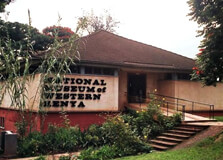
The Kitale Museum is a fascinating destination for history buffs, culture enthusiasts, and anyone interested in learning more about the rich heritage of Kenya. Located in the town of Kitale, in the western part of the country, the museum offers visitors an immersive experience into Kenya’s diverse cultural, historical, and natural heritage. From prehistoric fossils to colonial-era exhibits, Kitale Museum provides an excellent window into the history and traditions of the region. How to Reach Kitale Museum, Kitale Kitale Museum is conveniently located in the heart of Kitale town, making it easily accessible by both road and air. If you're traveling from Nairobi, Kitale is approximately 350 kilometers away, a journey that takes about 6 to 7 hours by car or bus. You can use a private vehicle, hire a taxi, or opt for a public bus or matatu (shared minivan). These buses and matatus operate from Nairobi’s central bus terminals such as the Nyamakima area and transport you directly to Kitale. If you prefer flying, the nearest airport is Eldoret International Airport, located about 75 kilometers away from Kitale. From Eldoret, you can take a taxi or hire a car to Kitale, which will take approximately 1 hour. Alternatively, Kitale has a small regional airstrip, but flights to it are less frequent compared to Eldoret. Weather and Timing Kitale enjoys a temperate climate due to its relatively high altitude of around 1,900 meters (6,200 feet) above sea level. The weather is generally mild throughout the year, with daytime temperatures ranging from 20°C (68°F) to 30°C (86°F). Nights can get cooler, especially during the rainy season, so it’s advisable to bring a light jacket if you're visiting in the evenings. The best time to visit Kitale Museum is during the dry season, which runs from June to September. The weather is generally more predictable, and the museum grounds are more comfortable for exploring. However, you can visit year-round, though the rainy season (from March to May and October to November) may make outdoor activities less pleasant, especially for those exploring the museum's beautiful garden or surrounding grounds. Why Kitale Museum, Kitale is Famous Kitale Museum is famous for its extensive collection of exhibits that reflect the diverse cultural and natural history of Kenya. One of its most notable features is its focus on the indigenous people of the region, with displays showcasing traditional tools, crafts, and artifacts. Visitors can learn about the various ethnic groups in Kenya, including the Kikuyu, Luhya, and Sabaot, and gain a deep understanding of their way of life, customs, and rituals. The museum is also well-known for its rich collection of paleontological fossils, some of which date back millions of years. These fossils provide insight into Kenya’s prehistoric past, showcasing the evolution of both flora and fauna in the region. One of the key highlights is the display of fossils from ancient animals that once roamed the area, such as prehistoric elephants and giant tortoises. Additionally, Kitale Museum offers a glimpse into the colonial era, with exhibits that highlight the impact of British settlers on the region. These displays focus on the history of colonialism, land acquisition, and the cultural exchange between European settlers and the indigenous communities. Entry and Visit Details About Kitale Museum, Kitale Kitale Museum is open to the public every day of the week, with visiting hours typically from 9:00 AM to 5:00 PM. The museum charges an entry fee, which varies depending on whether you are a local Kenyan resident or a foreign visitor. Tickets can be purchased at the entrance, and group rates are often available for schools, organizations, or larger parties. It is advisable to confirm the current rates with the museum’s administration before your visit. The museum is family-friendly and can be enjoyed by visitors of all ages. There are also guided tours available, which provide deeper insights into the exhibits and offer a more personalized experience. Local guides are knowledgeable and can share interesting facts and stories about the museum’s collections and the history of Kitale. History and Architecture of Kitale Museum Kitale Museum was founded in 1980 and is managed by the National Museums of Kenya (NMK). The museum is located on the grounds of a former colonial farm, which was originally owned by the British settler community. The farmstead was later transformed into the museum, preserving many of the original buildings, which are now part of the museum’s architecture. The museum’s main building is a colonial-era structure, with traditional East African architectural features such as high ceilings, wide verandas, and whitewashed walls. The building is surrounded by lush gardens, which further enhance the museum’s historical ambiance. The outdoor exhibits, including traditional huts and tools used by indigenous communities, blend seamlessly with the surrounding landscape, creating a tranquil and educational environment. Things to Do at Kitale Museum, Kitale There are plenty of activities to enjoy during a visit to Kitale Museum, ranging from guided tours to exploring the museum's beautiful grounds. Here are some of the top things to do: Explore the Paleontological Exhibits: Discover fossils from ancient animals that once roamed the region, including early hominids and extinct species. Learn About Kenya’s Ethnic Groups: The museum offers a detailed exploration of the various ethnic groups that make up Kenya’s diverse population. From traditional clothing and tools to sacred rituals, visitors can learn about the customs of the Kikuyu, Luhya, and other communities. Visit the Outdoor Exhibits: Explore the open-air exhibits that showcase traditional African huts, agricultural tools, and farming methods used by different communities. Tour the Colonial Farmhouse: The museum’s main building, a former colonial farmhouse, is open for exploration. Inside, visitors can learn about the history of British settlers in the region and the influence of colonialism on the local culture. Enjoy the Gardens: The museum grounds feature a beautiful garden, perfect for a relaxing stroll or a picnic. The well-maintained garden is home to various indigenous plants, making it an ideal spot for nature lovers. Interesting Facts About Kitale Museum, Kitale Kitale Museum is one of the oldest museums in Kenya, with a history dating back to 1980. The museum is located on the site of a former colonial farm, which was initially owned by British settlers. The museum is home to a large collection of paleontological fossils, some of which are millions of years old. In addition to its historical exhibits, the museum also features a variety of cultural artifacts from Kenya's indigenous communities. The museum’s gardens are a popular spot for picnics and relaxing walks, offering a peaceful environment for visitors. Travel Tips for Visiting Kitale Museum, Kitale Wear Comfortable Shoes: Be prepared to do a fair amount of walking, especially if you plan to explore the museum’s outdoor exhibits and gardens. Comfortable shoes are a must. Bring Sun Protection: The weather in Kitale can be warm during the day, so it's advisable to bring a hat, sunscreen, and sunglasses for protection. Stay Hydrated: Bring a bottle of water, especially if you plan on taking a guided tour or spending time outdoors. Engage a Guide: Hiring a local guide can enhance your experience, as they can provide more context about the exhibits and local history. Check for Special Events: Kitale Museum occasionally hosts special events, exhibitions, or cultural activities. It’s a good idea to check their website or call ahead to see if anything is happening during your visit.
Explore More10 Days Nuru Grand Safari Tour
10 Days/ 9 Night
Nairobi - Arusha - Nyeri - Samburu
3 Night - 4 Day Kenya Package
4 Days/ 3 Night
Nakuru - Masai Mara
The Great Rift Valley Circuit - Lake Nakuru - Lake Naivasha Tour
2 Days/ 1 Night
Nairobi - Nakuru
7 Days 6 Nights - Northern Kenya Explorer Tour
7 Days/ 6 Night
Nairobi - Nakuru - Masai Mara - Samburu
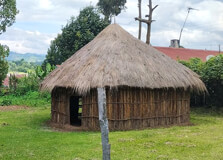
Kapenguria Museum is located in the town of Kapenguria, which is situated in the Trans-Nzoia County of Kenya, about 70 kilometers from Kitale. The museum is not only a center of learning and heritage but also a place that tells the rich history of Kenya's struggle for independence. It is one of the many attractions in the region and offers insight into the life of the famous "Kapenguria Six" and their contributions to the country’s independence. The museum's blend of historical significance, culture, and beautiful setting makes it a must-visit for anyone traveling through Kitale or the surrounding areas. How to Reach Kapenguria Museum, Kitale Kapenguria Museum is easily accessible from Kitale, with a road journey that takes approximately one hour. The town of Kapenguria is well-connected to Kitale via the Kitale-Kapenguria road. Visitors can easily hire a taxi or drive their own vehicles to reach the museum. Additionally, there are local matatus (shared taxis) available for transport between Kitale and Kapenguria, providing affordable options for travelers. If you're traveling from Nairobi, you can take a bus from Nairobi to Kitale, which is a 5-6 hour drive. Once in Kitale, you can continue your journey to Kapenguria by road. Alternatively, visitors traveling from Nairobi can opt to fly to Eldoret or Kitale and then take a road transfer to Kapenguria. The nearest airport to Kapenguria is Eldoret International Airport, located about 90 kilometers away. Weather and Timing Kapenguria experiences a moderate climate due to its elevation in the Rift Valley region. The weather is generally mild and pleasant throughout the year. During the day, temperatures typically range between 20°C (68°F) and 30°C (86°F), while nighttime temperatures can drop to around 12°C (54°F). The area experiences two main rainy seasons: long rains between March and May and short rains between October and December. The best time to visit Kapenguria Museum is during the dry seasons when the roads are more accessible and outdoor activities are more enjoyable. The museum is open every day of the week, with specific visiting hours between 9:00 AM and 5:00 PM. It is advisable to visit in the morning or early afternoon to avoid the afternoon showers that may occasionally occur during the rainy seasons. Make sure to check the weather forecast before planning your visit to ensure you are prepared for the conditions. Why Kapenguria Museum is Famous Kapenguria Museum is famous for its deep connection to Kenya’s independence history. It is best known as the place where the "Kapenguria Six," a group of prominent nationalist leaders, were tried for their involvement in the struggle for Kenya’s independence from British colonial rule. These leaders, including Jomo Kenyatta (Kenya’s first president), were imprisoned here in 1952 during the Mau Mau Uprising. Besides its political history, the museum is also famous for the exhibitions that highlight the cultural heritage of the local communities, including the Pokot and Bukusu people. The museum houses numerous artifacts that offer insights into Kenya’s diverse ethnic groups, as well as the country’s journey from pre-colonial times to independence. Entry and Visit Details About Kapenguria Museum, Kitale Visiting Kapenguria Museum is an enriching experience. The museum is open daily, and visitors can explore a variety of exhibitions that showcase Kenya’s history, particularly the freedom struggle. The entry fee is affordable, typically ranging between 200 to 500 KES for locals and around 1000 KES for foreign visitors, but it’s always good to check with the museum before planning your visit. Guided tours are available for visitors who wish to learn more about the exhibits, the significance of the museum, and the story of the Kapenguria Six. The tours provide historical context and an in-depth understanding of the museum’s cultural and political importance. It's advisable to book tours in advance, especially during peak tourist seasons. Besides the main museum building, there is a beautifully landscaped garden surrounding the facility, where visitors can relax and enjoy the serenity. The museum also has a small gift shop where visitors can purchase souvenirs, including books, artifacts, and local crafts, as a memento of their visit. History and Architecture of Kapenguria Museum Kapenguria Museum was established to preserve the historical significance of the town and the surrounding region. The building itself was once a colonial government administrative center, and it was used as a prison where the Kapenguria Six were detained in 1952. The structure retains its colonial architectural style, with simple yet functional designs that reflect the era's utilitarian approach to construction. Since its transformation into a museum, the building has been renovated to house various exhibits that narrate the history of Kenya’s struggle for independence, as well as the cultural heritage of the region. The museum’s exhibits are arranged in well-organized sections, each showcasing different aspects of Kenya's history, including colonialism, the fight for independence, and the post-independence era. Things to Do at Kapenguria Museum, Kitale While visiting Kapenguria Museum, there are several activities and experiences to enjoy: Explore the Historical Exhibits: Learn about the life of the Kapenguria Six, the history of the Mau Mau Uprising, and Kenya’s road to independence through engaging and informative exhibits. Take a Guided Tour: A guided tour will give you a more in-depth understanding of the museum’s history, the significance of the artifacts, and the impact of the Kapenguria Six on Kenya's independence. Visit the Garden: The museum is surrounded by a beautiful garden, perfect for a leisurely walk or a peaceful rest in nature after exploring the exhibits. Learn about Local Cultures: The museum also highlights the cultures and traditions of the local communities, particularly the Pokot and Bukusu people. Visitors can view various artifacts, including traditional clothing, tools, and handicrafts. Photography: The museum offers several opportunities for photography, both inside the museum and in the scenic garden outside. Be sure to capture the historical and cultural beauty of the site. Interesting Facts About Kapenguria Museum, Kitale The Kapenguria Museum was originally a colonial administrative building before being converted into a museum. It is famous for being the site where Jomo Kenyatta and the other members of the Kapenguria Six were tried and imprisoned in 1952. The museum is a key symbol of Kenya’s independence movement and a must-visit for anyone interested in the country’s history. The museum also serves as a center for cultural education, displaying artifacts from the local Pokot and Bukusu communities. Visitors can explore the original prison cells where the Kapenguria Six were held and learn about their struggles for Kenya's independence. Travel Tips for Visiting Kapenguria Museum, Kitale Plan Ahead: Check the opening hours of the museum and, if possible, book a guided tour in advance to enhance your experience. Pack Light: Comfortable shoes and light clothing are recommended, as you will be walking around the museum and its surrounding grounds. Respect Local Customs: The museum holds significant cultural and historical value, so be mindful of the local customs and traditions when visiting. Bring a Camera: The museum’s historical artifacts and beautiful garden offer many opportunities for photography, so don't forget your camera. Be Prepared for the Weather: While the weather in Kapenguria is generally mild, it can be rainy during certain months, so it's a good idea to bring a raincoat or umbrella if you're visiting during the rainy season.
Explore More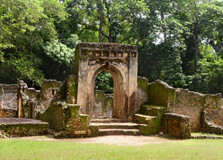
The Gede Museum, located just a few kilometers from the coastal town of Malindi in Kenya, is a fascinating historical and archaeological site that attracts both local and international tourists. The museum is housed within the ruins of the ancient Gede city, an archaeological site that dates back to the 12th century and offers a glimpse into the rich Swahili culture of East Africa. A visit to the Gede Museum is an opportunity to step back in time and explore the mysteries of an ancient civilization that flourished in this region long before the arrival of the Portuguese and other European colonizers. History and Architecture Gede, the site where the museum is located, was once a thriving city that played a significant role in the history of the Swahili coast. It is believed to have been established around the 12th century and flourished for several hundred years before mysteriously being abandoned around the 17th century. The reasons for the city's abandonment are not entirely clear, but scholars speculate that factors such as changes in trade routes, invasion, or environmental changes may have played a role. The ruins of Gede, now preserved as a National Monument, include the remains of a mosque, houses, and a fortress, all built in a distinctive Swahili architectural style using coral stone and other locally sourced materials. The structures, which have been carefully excavated and restored, offer a rare insight into the living conditions and architectural style of the Swahili people during the city's peak. The Gede Museum, which is situated within this archaeological site, houses artifacts discovered during excavations, including pottery, coins, tools, and jewelry, providing further evidence of the advanced civilization that once thrived here. Why It's Famous The Gede Museum is famous for being a window into the past, offering visitors the chance to explore one of the best-preserved Swahili archaeological sites on the East African coast. The ruins of Gede are considered an important cultural and historical landmark, shedding light on the Swahili people’s way of life and their trade relationships with other parts of the Indian Ocean world. Additionally, the site is famous for its unique blend of African, Arab, and Persian influences, which can be seen in the architecture, pottery, and artifacts found here. One of the key reasons for its fame is the sense of mystery that surrounds the site. The city of Gede was abandoned over 300 years ago, and the reasons behind its fall remain speculative. The ruins, combined with the legends and historical accounts of the region, have added to the intrigue surrounding the site, making it a must-visit location for history buffs and cultural enthusiasts alike. Entry and Visit Details The Gede Museum is open to visitors year-round, and entry is affordable for both locals and tourists. The museum offers a comprehensive exploration of the ruins, with guided tours available to help visitors understand the historical significance of the site. The entry fee for non-residents is approximately USD 10, while residents can enter for a lower fee. Children and students may also receive discounted rates. The museum is open daily from 8:00 AM to 5:00 PM, providing plenty of time for visitors to explore the ruins, view the exhibits, and enjoy the beautiful surroundings. The museum also offers a small shop where visitors can purchase souvenirs, including local crafts and artifacts inspired by the Swahili culture. How to Reach Gede Museum Gede Museum is located about 16 kilometers south of Malindi, making it easily accessible by road. There are several ways to reach the museum: By Car: From Malindi, visitors can take a taxi or rent a car to reach Gede. The drive takes about 20-30 minutes. The road is well-maintained, making it easy to navigate. By Public Transport: Local matatus (shared minibuses) traveling between Malindi and other parts of the region will pass near the Gede Museum. Visitors can ask to be dropped off at the Gede turnoff, from where it is a short walk to the museum. By Guided Tour: Many tour operators in Malindi offer guided tours that include a visit to the Gede Museum. This is a convenient option for those who prefer to explore with an expert guide who can provide additional insights into the site's history. Weather and Best Time to Visit Malindi, including the Gede Museum, experiences a tropical climate with warm temperatures throughout the year. The best time to visit is during the dry season, which runs from December to March. During this period, the weather is sunny and ideal for outdoor exploration, making it the perfect time to visit the museum and the surrounding ruins. During the rainy season, which typically occurs from April to June, the area can experience heavy downpours, making travel and outdoor activities less enjoyable. It is advisable to check the weather forecast before planning your visit to ensure the best conditions for exploring the site. Things to Do at Gede Museum In addition to exploring the ancient ruins, there are several activities that visitors can enjoy during their trip to Gede Museum: Guided Tours: Visitors can take a guided tour of the Gede ruins, which provides a deeper understanding of the site’s history and significance. Knowledgeable guides offer fascinating insights into the architecture, cultural practices, and mysteries surrounding the abandonment of the city. Photography: The ancient coral stone structures, lush surroundings, and beautiful landscapes make Gede an ideal spot for photography. Visitors can capture images of the ruins, as well as the nearby forest and wildlife. Nature Walks: The Gede Museum is set within a forested area, making it a great place for nature walks. Visitors can explore the surrounding forest and enjoy the rich biodiversity of the region, including various bird species and wildlife. Visit the Gift Shop: The museum’s gift shop offers a range of souvenirs, including local crafts, jewelry, and artifacts inspired by the Swahili culture. It’s a great place to pick up a memento of your visit. Facts and Tips About Gede Museum Bring Comfortable Footwear: The Gede ruins are spread out across a large area, and visitors will need to do some walking. Wear comfortable shoes, especially if you plan to explore the surrounding forest. Respect the Site: As an important cultural and historical monument, visitors are encouraged to respect the site by not touching the ancient ruins or disturbing the natural environment. Follow the guidance of the museum staff and your tour guide. Explore Nearby Attractions: While at Gede, consider exploring nearby attractions, such as the Gede Forest, known for its rich biodiversity, and the nearby beaches of Malindi and Watamu. The area offers excellent opportunities for birdwatching and nature walks. Bring Water and Snacks: The museum grounds are relatively large, and visitors may want to bring water and snacks to stay hydrated and energized during their visit. There are limited food options available on-site, so it’s best to plan ahead. Conclusion The Gede Museum offers a unique and enriching experience for history enthusiasts, culture seekers, and nature lovers. Set within the ancient ruins of the Swahili city of Gede, the museum provides a fascinating insight into the history of the Swahili Coast and the mysterious rise and fall of this once-thriving civilization. Whether you’re exploring the ruins, learning about the artifacts in the museum, or enjoying a nature walk through the surrounding forest, Gede Museum is a must-visit destination for anyone traveling to the Malindi area. Its blend of history, culture, and natural beauty makes it one of Kenya’s most intriguing and rewarding historical sites.
Explore More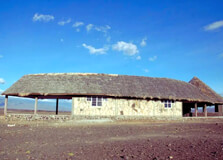
The Desert Museum in Marsabit, Kenya, is a unique cultural and ecological attraction that showcases the rich biodiversity, cultural heritage, and traditional lifestyles of the arid and semi-arid regions of northern Kenya. Located in Marsabit town, the museum is dedicated to preserving and educating visitors about the delicate desert ecosystem and the various indigenous communities that thrive in this challenging environment. It serves as an important center for research, conservation, and tourism, offering a fascinating glimpse into the desert's natural history and cultural traditions. How to Reach The Desert Museum, Marsabit The Desert Museum is conveniently located in Marsabit town, which is the main urban center in Marsabit County. Traveling to the museum involves reaching Marsabit first, and then a short trip to the museum itself. By Road: From Nairobi, Marsabit is approximately 700 kilometers north, and the drive takes around 12 to 14 hours. The route passes through Isiolo town and continues on mostly tarmac roads until you approach Marsabit, where roads might become rougher. Marsabit town is well-connected by road, and the museum is easily accessible once you arrive. By Air: Marsabit has a small airstrip served by local airlines from Nairobi Wilson Airport. The flight duration is about 1.5 hours. Upon landing, a short drive within Marsabit town will bring you to the Desert Museum. From Muscat: For travelers coming from Muscat, Oman, the best route is to fly to Nairobi’s Jomo Kenyatta International Airport, then connect by road or air to Marsabit. Direct flights between Muscat and Nairobi are common, making the journey straightforward. Weather Around The Desert Museum, Marsabit Marsabit is located in a semi-arid zone, meaning it experiences warm to hot temperatures for much of the year, but the altitude provides some relief. Daytime temperatures generally range from 25°C to 30°C (77°F to 86°F), but nights can be cooler, sometimes dropping to around 15°C (59°F). The region experiences two main rainy seasons: the long rains from March to May, and the short rains in October and November. The rest of the year is relatively dry, which is typical of desert environments. Visitors should expect dry, dusty conditions but can also enjoy the cooler mountain air around Marsabit town where the museum is located. Timing to Visit The Desert Museum The best time to visit The Desert Museum is during the dry seasons, from June to September and from December to February. During these months, the weather is more stable, and travel conditions are easier. Visiting during the rainy seasons might add beauty to the landscape, with greener surroundings, but some roads may become difficult to navigate. Early morning or late afternoon visits are ideal for a comfortable experience, avoiding the midday heat. Why The Desert Museum, Marsabit is Famous The Desert Museum is famous for several reasons: Unique Focus on Desert Ecology: Unlike many other museums in Kenya, this museum is dedicated to the drylands ecosystem, highlighting how life survives and adapts in harsh desert conditions. Cultural Preservation: The museum showcases the culture, traditions, and history of the indigenous peoples of northern Kenya, such as the Rendille, Borana, Gabra, and Dassanech communities. Educational Resource: It serves as a center for research and education on desert wildlife, plants, and sustainable living practices that are vital to the region’s survival. Conservation Efforts: The museum supports local conservation initiatives aimed at protecting endangered desert species and preserving the natural environment. Entry and Visit Details About The Desert Museum, Marsabit Visitors to The Desert Museum can expect a welcoming environment with informative displays and interactive exhibits. The museum is open daily, typically from 9:00 AM to 5:00 PM. Entry fees are modest, contributing to the upkeep of the museum and conservation projects. It is advisable to check for updated opening hours and ticket prices before visiting. The museum is accessible to visitors of all ages and offers guided tours for those who want a deeper understanding of the exhibits. Educational programs for schools and groups are also organized regularly. Photography is usually allowed inside the museum, but it is best to confirm with the staff regarding any restrictions. History and Architecture of The Desert Museum The Desert Museum was established to fill a gap in the representation of Kenya’s diverse ecosystems, focusing on the drylands which cover much of northern Kenya. The museum building itself reflects local architectural styles, blending traditional designs with modern functionality. Constructed using locally sourced materials, it features natural stone walls, wooden beams, and open spaces that allow natural light to illuminate the exhibits. The museum’s design incorporates eco-friendly principles, including natural ventilation and minimal environmental impact. This architectural approach not only respects the local culture but also harmonizes with the harsh desert environment, demonstrating sustainability in practice. Things to Do at The Desert Museum The Desert Museum offers a variety of activities and experiences for visitors, including: Exploring Exhibits: Learn about desert flora and fauna, traditional tools, crafts, and the lifestyles of desert communities. Guided Tours: Participate in guided tours led by knowledgeable staff who provide insights into the exhibits and local culture. Workshops and Demonstrations: Occasionally, the museum hosts cultural workshops, such as traditional craft making and storytelling sessions. Bird Watching: The museum grounds are near Marsabit Forest and attract various bird species, making it an excellent spot for birdwatchers. Visiting Nearby Attractions: Combine your visit with trips to Marsabit National Park, Lake Paradise, or the Marsabit Forest for a full northern Kenya experience. Interesting Facts About The Desert Museum, Marsabit The Desert Museum is one of the few museums in Africa specifically dedicated to arid and semi-arid ecosystems. It showcases how indigenous people adapt to one of the toughest climates on earth through sustainable living practices. The museum supports ongoing scientific research on desert wildlife, including endangered species like Grevy’s zebra and the Somali ostrich. Local artisans contribute traditional crafts and artworks, making the museum also a hub for cultural preservation and promotion. Tips for Visiting The Desert Museum, Marsabit Wear comfortable clothing suitable for warm weather but bring a light jacket for cooler mornings and evenings. Carry water and sun protection, such as hats and sunscreen, especially if visiting during the hotter months. Engage a local guide to gain deeper insights into the exhibits and the cultural context. Plan your visit early in the day to avoid the midday heat and have enough time to explore all exhibits. Combine your museum visit with other attractions in Marsabit to fully experience the natural and cultural richness of the area.
Explore More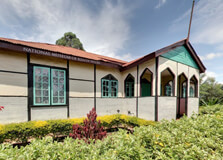
Nyeri Museum is a significant cultural and historical institution located in Nyeri town, in the central highlands of Kenya. It plays a vital role in preserving Kenya’s colonial, traditional, and political history. Housed in a former colonial courthouse built in the early 20th century, the museum provides a fascinating look into Kenya's past, offering exhibits that reflect the struggles, heritage, and transformation of the nation over the decades. This relatively small but important museum is managed by the National Museums of Kenya and has steadily grown to become an educational center for both locals and international tourists. The Nyeri Museum is especially popular among students, history enthusiasts, and researchers interested in Kenya’s journey from colonial rule to independence. How to Reach Nyeri Museum, Nyeri Nyeri Museum is located in Nyeri town, which is approximately 150 kilometers north of Nairobi. Reaching the museum is straightforward: By Road: From Nairobi, drive along the Thika Superhighway (A2) via Karatina to Nyeri. The trip takes about 3 to 4 hours. Once in Nyeri town, the museum is located near the Nyeri Law Courts, close to the town center. By Public Transport: Matatus and buses from Nairobi to Nyeri operate daily. From the Nyeri town center, you can take a taxi or walk to the museum, which is within walking distance from most hotels and central locations. By Air: Though there is no major airport in Nyeri, the nearby Nanyuki Airstrip or the Nyeri Airstrip (for chartered flights) can be used, followed by a short road trip to the museum. Weather in Nyeri Nyeri enjoys a temperate climate due to its location in the highlands. The area is generally cool and pleasant throughout the year, making it a comfortable place to explore historical sites. Average Temperature: Daytime temperatures range from 18°C to 25°C. Nights can be cooler, dropping to around 10°C. Rainy Seasons: The long rainy season occurs between March and May, and the short rains fall between October and November. Best Time to Visit: Dry months from June to September and December to February are ideal for travel and sightseeing. Timings The Nyeri Museum is open to visitors on all days except public holidays. Opening Hours: 8:00 AM to 5:00 PM (Monday to Sunday) Closed on: Some national public holidays Recommended Visit Duration: 1 to 2 hours is sufficient to explore the museum thoroughly. Why Famous for Nyeri Museum, Nyeri? Nyeri Museum is famous for its deep historical relevance and for being one of the few institutions that narrate Kenya’s colonial past through well-preserved artifacts, documents, and photography. It is especially known for: Being located in a former colonial courthouse, which in itself is a piece of history. Exhibiting stories related to Kenya's Mau Mau uprising and political struggle. Showcasing traditional Kikuyu cultural practices and pre-colonial artifacts. Serving as a research and educational center for students and tourists. Entry and Visit Details about Nyeri Museum, Nyeri Entry Fee: Locals – KES 100; Non-residents – around KES 500; Students – discounted rates available. Photography: Allowed, though flash may be restricted for certain artifacts. Guided Tours: Available upon request. Museum staff or guides provide detailed explanations of the exhibits. Accessibility: The museum is wheelchair-accessible and has restrooms for visitors. History and Architecture The Nyeri Museum building originally served as a courthouse during the British colonial period. Its construction dates back to the early 1900s, and it played a crucial role in the administration of colonial law and order. The building has been preserved in its original form, including the courtroom where colonial trials were held. Architecturally, the museum reflects British colonial style — simple yet functional, with stone walls, high ceilings, large windows for ventilation, and a prominent entrance. Some of the original wooden benches and interior fittings are still intact, adding authenticity to the visitor experience. The transformation from a courthouse to a museum was part of a broader initiative to preserve Kenya’s cultural history and promote public awareness of the nation’s heritage. Things to Do at Nyeri Museum Explore Historical Exhibits: Learn about the Mau Mau rebellion, Kenyan heroes, colonial law, and local customs. See Traditional Artifacts: View farming tools, household items, and ceremonial objects from various Kenyan communities. View the Courtroom: Step inside the original colonial courtroom and visualize the justice system of the time. Participate in Learning Programs: School tours and educational sessions are often organized for groups. Photography: Capture photos of the exhibits and the beautiful colonial architecture. Facts about Nyeri Museum It is one of the few museums in Kenya located in a building of historical political significance. The museum includes exhibits on Kenya’s journey to independence and notable figures from the Nyeri region. It is managed by the National Museums of Kenya. Popular with students from local schools and universities for educational field trips. Includes both indoor and small outdoor exhibit areas. Tips about Nyeri Museum, Nyeri Visit on weekdays for a quieter and more focused experience. Hire a guide for more detailed insight into the historical context of the exhibits. Carry a notebook or mobile device for taking notes if you're researching Kenyan history. Respect signage and barriers around sensitive artifacts. Combine your museum visit with a trip to other nearby attractions like the Italian War Memorial Church or the Baden-Powell grave site.
Explore More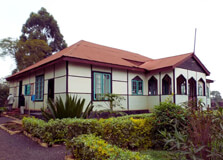
The Nyeri County Museum is a prominent cultural and historical landmark located in Nyeri town, central Kenya. This museum is dedicated to preserving the rich history and heritage of Nyeri County, with a particular focus on the cultural traditions, art, and historical events that shaped the region. The museum offers visitors an opportunity to learn about the diverse ethnic groups that have inhabited Nyeri, the significance of the area during Kenya’s independence struggle, and its contributions to the nation’s cultural and historical fabric. How to Reach The Nyeri County Museum, Nyeri The Nyeri County Museum is located in the heart of Nyeri town, which is approximately 150 kilometers north of Nairobi. The museum is easily accessible via various modes of transportation: By Road: The most common way to reach Nyeri is by road. From Nairobi, you can drive via the Nairobi-Nanyuki highway, which typically takes about 3 to 4 hours, depending on traffic. The museum is located within Nyeri town, so it is easily accessible by public transport or taxi once you arrive in the town. From Muscat: To reach Nyeri from Muscat, Oman, you will need to take a flight to Nairobi’s Jomo Kenyatta International Airport. From Nairobi, you can hire a taxi or take a bus to Nyeri. Public buses and private shuttle services are available to Nyeri from Nairobi. Weather at The Nyeri County Museum Nyeri, being located in the central highlands of Kenya, enjoys a mild and temperate climate, making it an ideal destination for year-round visits. The weather is generally pleasant, with daytime temperatures ranging from 20°C to 25°C (68°F to 77°F) and cooler evenings, especially in the higher elevations. The region experiences two rainy seasons: the long rains from March to May and the short rains from October to December. During the dry season, from June to September, the weather is more predictable and ideal for exploring the museum and other outdoor attractions in Nyeri. Visitors should carry light clothing during the day and a jacket for cooler evenings. Timing to Visit The Nyeri County Museum The Nyeri County Museum is generally open to visitors throughout the week. It is recommended to visit during the dry months, from June to September, when the weather is more favorable for outdoor exploration. The museum operates from 9:00 AM to 5:00 PM, and it is best to visit during these hours to fully enjoy the exhibits and the historical significance of the place. During the rainy season, the museum can still be visited, but outdoor activities and walking tours may be affected by the weather conditions. It is advisable to check the weather forecast before planning your visit to ensure a smooth experience. Why The Nyeri County Museum is Famous The Nyeri County Museum is famous for its role in preserving and showcasing the rich cultural history of Nyeri and the larger central Kenya region. The museum offers an in-depth look into the area’s traditions, the history of its people, and its important role in Kenya’s struggle for independence. The museum's collection includes artifacts, photographs, and documents that reflect the diverse cultures of Nyeri, from the Kikuyu people to the various ethnic communities that have settled in the region. One of the key attractions of the museum is its focus on the role Nyeri played during Kenya's independence, including its connection to notable figures such as Jomo Kenyatta, the first president of Kenya, who had significant ties to the area. The museum also highlights the cultural contributions of the Kikuyu people, who are the dominant ethnic group in Nyeri County. Entry and Visit Details About The Nyeri County Museum The Nyeri County Museum is open to both local and international visitors. The entry fee is affordable, with discounted rates available for Kenyan citizens and students. International visitors are typically charged a slightly higher fee, but it is still reasonable compared to other historical sites in Kenya. The museum offers guided tours to visitors, where knowledgeable guides provide detailed explanations of the exhibits, history, and significance of the site. The museum is located in a serene environment with beautiful gardens surrounding the building. Visitors can take time to explore the outdoor exhibits, which include traditional artifacts and sculptures that represent the rich cultural heritage of the area. The museum also has a gift shop where visitors can purchase local handicrafts and souvenirs as a memento of their visit. History and Architecture of The Nyeri County Museum The Nyeri County Museum is housed in a colonial-era building that reflects the architectural style of the early 20th century. The building itself is an important part of the region's historical landscape, as it has stood for decades and witnessed the evolution of Nyeri from a small town to a vibrant center of commerce and culture. The museum was established to preserve and showcase the cultural and historical heritage of the region. Its exhibits include traditional tools, clothing, artwork, and historical records that trace the history of Nyeri and its people. One of the most notable sections of the museum is dedicated to the life and legacy of Jomo Kenyatta, whose connections to Nyeri played a significant role in Kenya’s path to independence. Visitors can explore sections of the museum that highlight the history of the Kikuyu people, the agricultural practices of the region, and the role of the British colonial administration in shaping the area’s development. The museum’s architecture complements its purpose by combining historical style with a modern layout that facilitates an interactive visitor experience. Things to Do at The Nyeri County Museum A visit to The Nyeri County Museum is an enriching experience. Here are some activities visitors can enjoy during their trip: Explore the Exhibits: The museum has a variety of exhibits showcasing the culture, art, and history of Nyeri and central Kenya. Visitors can learn about the Kikuyu people's traditions, the British colonial presence, and the struggle for independence. Take a Guided Tour: The museum offers guided tours that provide deeper insight into the history and significance of the exhibits. The knowledgeable guides offer valuable perspectives on Kenya’s independence and the cultural richness of Nyeri. Visit the Outdoor Exhibits: The museum’s outdoor section features traditional huts, artifacts, and sculptures that represent the local heritage. These provide a unique opportunity to explore Kenya’s rural past and understand the way of life of the early communities. Buy Souvenirs: The museum shop offers a range of local handicrafts, including woven baskets, beadwork, and wood carvings. These make great souvenirs for visitors wanting to take a piece of Nyeri home. Interesting Facts About The Nyeri County Museum The museum is located near the site where Jomo Kenyatta, Kenya's first president, spent much of his life, making it a significant historical location. Nyeri County is home to several important cultural sites, and the museum plays a key role in preserving the region's history. The museum’s collection includes rare and valuable artifacts, many of which date back to the pre-colonial era, providing an invaluable glimpse into the area’s past. In addition to cultural exhibits, the museum often hosts temporary exhibitions on contemporary Kenyan art, photography, and history. The Nyeri County Museum is part of the National Museums of Kenya network, which operates museums across the country. Tips for Visiting The Nyeri County Museum Wear Comfortable Shoes: The museum has both indoor and outdoor sections, so comfortable footwear is recommended for exploring the entire site. Bring a Camera: The museum offers many opportunities for photography, including scenic views of Nyeri and the surrounding highlands. Plan for a Guided Tour: Consider taking a guided tour to learn more about the exhibits and their historical significance. Guides are knowledgeable and provide enriching details that might be missed on a self-guided tour. Check for Special Exhibitions: The museum frequently holds temporary exhibitions, so it’s worth checking their schedule to see if any special displays coincide with your visit. Respect the Site: As a place of cultural significance, visitors are encouraged to maintain a respectful demeanor while exploring the museum.
Explore More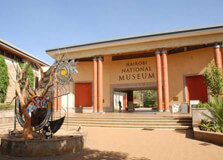
The Eldoret Railway Museum, located in the heart of Eldoret town in Kenya, is a fascinating place for history buffs, railway enthusiasts, and anyone interested in learning about the history of Kenya's transportation system. The museum is a unique destination that offers visitors the opportunity to explore the rich legacy of the railway system in East Africa and its role in the development of Kenya. Whether you're interested in the steam engines of the past or the evolution of modern rail travel, the Eldoret Railway Museum is an essential stop for those traveling through the region. How to Reach Eldoret Railway Museum, Eldoret Getting to the Eldoret Railway Museum from Muscat involves a combination of air travel and road transportation. Here’s how you can reach the museum: By Air: Start by flying from Muscat (MCT) to Nairobi (NBO) at Jomo Kenyatta International Airport. The flight takes approximately 5 hours and 30 minutes. From Nairobi, you can take a domestic flight to Eldoret International Airport (EDL), which takes about 1 hour. By Road: Once you arrive in Eldoret, the Eldoret Railway Museum is located just a few minutes from the town center, making it easily accessible by car. You can take a taxi or use public transport, such as matatus (shared minibuses), to reach the museum. The drive from Eldoret International Airport to the museum typically takes around 30 minutes. Weather and Timing at Eldoret Railway Museum The weather in Eldoret is generally temperate due to its high-altitude location in the Rift Valley. It is known for its cool climate, which makes it pleasant to explore the museum and the surrounding areas. Below are some key details regarding the weather and operating hours: Climate: The average temperature in Eldoret ranges from 14°C to 24°C. The climate is mild and cool, with a slight variation in temperature between the day and night. The rainy season occurs between March and May, while the dry season lasts from June to October, offering pleasant weather for outdoor activities. Best Time to Visit: The best time to visit the Eldoret Railway Museum is during the dry season, particularly from June to October. This is when the weather is most comfortable for sightseeing. However, the museum is open year-round, and the rainy season offers a quieter experience with fewer visitors. Operating Hours: The museum is generally open from 9:00 AM to 5:00 PM, Monday to Saturday. It remains closed on Sundays, but private arrangements may be made for group visits if necessary. It’s advisable to confirm the timings before visiting, especially during holidays or special events. Why Eldoret Railway Museum is Famous The Eldoret Railway Museum is famous for its rich history and collection of artifacts related to the development of Kenya’s railway system. Some reasons why the museum is so well-known include: Historical Significance: The museum provides a glimpse into the history of the Kenya-Uganda Railway, which played a pivotal role in the country's development. The railway line, which was constructed during the colonial era, connected Nairobi to Mombasa and later extended to Uganda. The Eldoret Railway Museum showcases many relics from this era, including old locomotives, wagons, and rail-related equipment. Railway Artifacts: Visitors can view a wide array of exhibits, including vintage steam engines, railway carriages, and even old railway maps that depict the development of East Africa’s railway network. The museum's collection of railway memorabilia is unmatched in the region and offers a deep dive into the evolution of rail transport in Kenya. Educational Value: The museum is a fantastic educational resource, particularly for school groups, history lovers, and railway enthusiasts. It offers an in-depth understanding of the challenges and triumphs involved in building Kenya's railway infrastructure. Entry and Visit Details About Eldoret Railway Museum If you’re planning a visit to the Eldoret Railway Museum, here’s everything you need to know about entry fees and other important details: Entry Fees: The entry fees to the Eldoret Railway Museum are very affordable, making it a great destination for families, students, and budget travelers. The museum charges a small fee, typically around KES 100 to 300 (Kenyan Shillings), depending on whether you're a local resident or a foreign visitor. Special rates are often available for group tours or school visits. Guided Tours: For a more informative experience, guided tours are available. These tours provide detailed insights into the exhibits and the history of the railway system in Kenya. Trained guides are knowledgeable about the collection and can share interesting stories and facts about the history of the railway. Accommodation: While there is no accommodation within the museum itself, Eldoret town offers a wide range of hotels and lodges to suit different budgets. From budget-friendly guesthouses to luxury hotels, you will find numerous options to choose from. Most accommodations are within a 10-minute drive from the museum. History and Architecture of Eldoret Railway Museum The Eldoret Railway Museum has a rich history that dates back to the early 20th century, during the British colonial period. The railway network was constructed to connect the coast of Kenya to Uganda, facilitating trade and the movement of goods and people. The museum itself is housed in a historic building that was once part of the colonial railway depot in Eldoret. Architecturally, the museum showcases colonial-era structures, with its old train station building standing as a reminder of the past. The museum’s collection includes restored steam engines, railway cars, and other machinery that played a significant role in shaping Kenya's transportation infrastructure. The trains displayed at the museum have been carefully restored to their original condition, and visitors can take a closer look at the mechanics and history behind them. Things to Do at Eldoret Railway Museum There are several things you can do during your visit to the Eldoret Railway Museum: Explore the Exhibits: The main activity at the museum is exploring the wide variety of exhibits on display. These include old trains, railway equipment, and historical photographs documenting the development of Kenya’s railway system. Learn About Kenya's Railway History: Take a guided tour to gain a deeper understanding of the history of the Kenya-Uganda Railway and the challenges faced in building the railway line through difficult terrain. Photography: The museum provides fantastic opportunities for photography. Capture images of the vintage trains, the surrounding railway artifacts, and the historic architecture of the station. Visit the Museum’s Gift Shop: The museum has a small gift shop that sells souvenirs, including railway-themed items and historical memorabilia. It's a great place to pick up unique mementos of your visit. Facts About Eldoret Railway Museum The museum is located just outside Eldoret Town, easily accessible from the main highway. It was established to preserve the legacy of the Kenya-Uganda Railway and educate the public about its historical importance. The museum houses a variety of steam locomotives, carriages, and equipment, many of which are over 100 years old. The museum is part of a broader initiative to preserve East Africa's railway heritage and promote tourism in the region. Tips for Visiting Eldoret Railway Museum Plan Ahead: Check the museum's opening hours and entry fees in advance to ensure that you're well-prepared for your visit. Bring Comfortable Shoes: Expect to do some walking around the museum, so wear comfortable shoes suitable for exploring the grounds. Engage with the Guides: Make sure to hire a guide for a more enriching experience, as they can share fascinating stories and information about the exhibits. Take Photos: Don’t forget to bring your camera or smartphone to capture the historic trains and the scenic surroundings of the museum.
Explore More